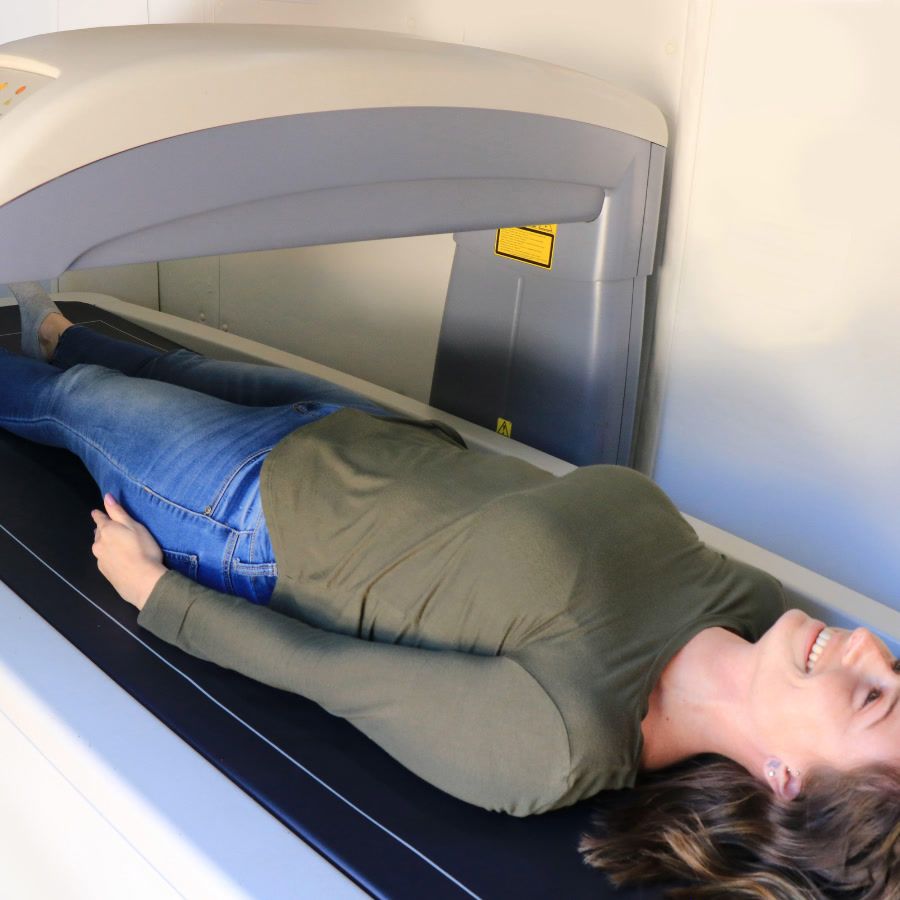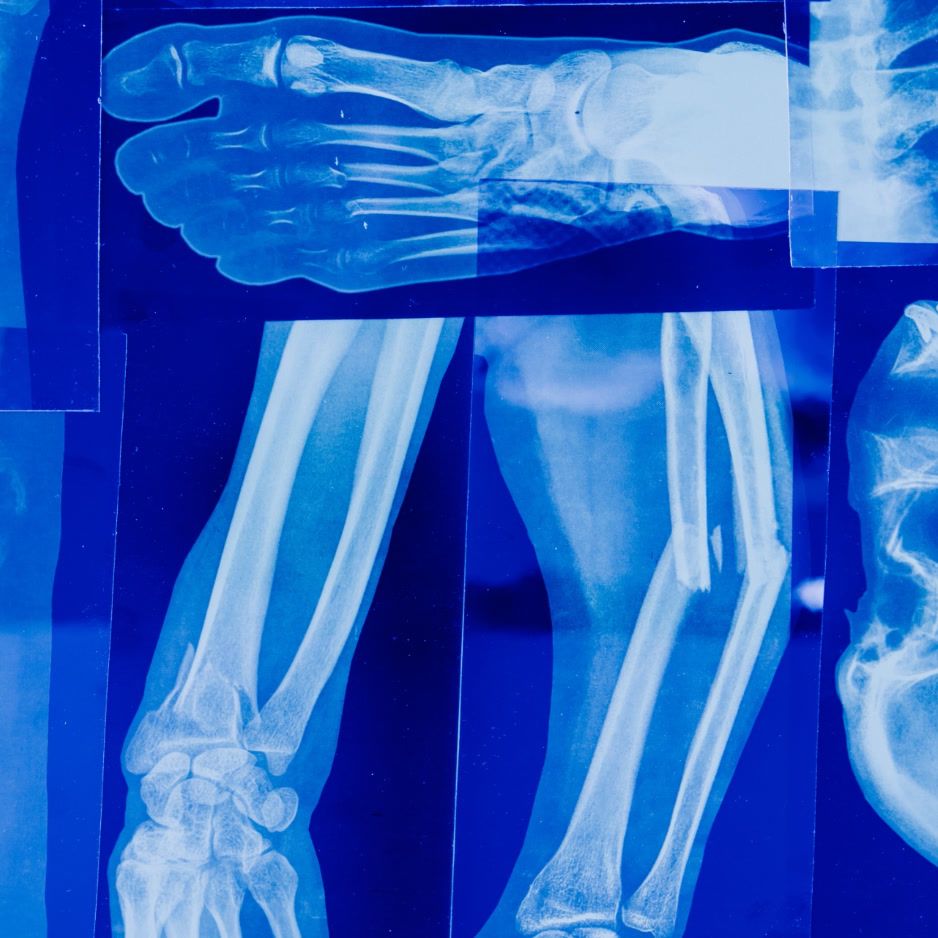3-Day Water Fast: A Complete Guide to Weight Loss, Benefits, Risks & Safety

3-Day Water Fast: A Complete Guide to Weight Loss, Benefits, Risks & Safety
For centuries, water fasting has been practiced across various cultures for therapeutic and spiritual purposes. A 72-hour water fast, which involves consuming only water for three consecutive days, can trigger profound metabolic changes including autophagy, enhanced insulin sensitivity, and rapid fat loss. However, it also carries significant risks that make medical supervision essential for most people.
This comprehensive guide examines what current research reveals about 3-day water fasting, realistic weight loss expectations, who should avoid it, and how to approach it safely if you're considering this extreme form of intermittent fasting.
⚠️ CRITICAL SAFETY NOTICE: A 3-day water fast is a medical intervention that can affect blood sugar, blood pressure, and electrolyte balance. Always consult a healthcare provider before attempting any extended fast, especially if you have medical conditions, take medications, or have a history of eating disorders.
TL;DR – Most People Drop 2–6 lbs in 72 Hours
Weight Loss Breakdown:
- ≈70–80% is rapid water weight—including liver glycogen and its bound water that depletes early in the fast. This portion rebounds fastest once you resume carbs and sodium.
- ≈15–25% is body-fat mass—roughly 0.5–1.5 lbs depending on your size and body-fat level.
- Lean mass also dips temporarily because muscles lose internal water and glycogen—not because you're shedding significant actual muscle protein.
What Is a 3-Day Water Fast?
A 3-day water fast involves consuming only water for 72 hours while abstaining from all food, caloric beverages, and supplements. Unlike popular intermittent fasting methods like 16:8 or OMAD, this extended fast pushes your body through distinct metabolic phases that don't occur during shorter fasting periods.
How It Differs from Intermittent Fasting
| Fasting Method | Duration | Primary Benefits | Difficulty Level |
|---|---|---|---|
| 16:8 | 16 hours daily | Weight loss, convenience | Beginner |
| 20:4 | 20 hours daily | Enhanced autophagy, fat loss | Advanced |
| 3-Day Water Fast | 72 hours | Deep autophagy, metabolic reset | Expert only |
The 3-day duration is significant because it allows your body to transition through multiple metabolic phases, including glycogen depletion, ketosis, and deeper cellular repair processes that shorter fasts cannot trigger.
Realistic Weight Loss Expectations by Starting Weight
| Starting Weight | Total Loss (lbs) | Water & Glycogen | Fat Mass | Lean Mass* |
|---|---|---|---|---|
| 120 lbs | 2–3 | 1.5–2 | 0.4–0.6 | Up to 0.2 |
| 150 lbs | 3–5 | 2.5–3.5 | 0.6–1.0 | Up to 0.3 |
| 180 lbs | 4–6 | 3–4 | 0.8–1.3 | Up to 0.4 |
| 210 lbs | 5–7 | 3.5–4.5 | 1.0–1.6 | Up to 0.5 |
"Lean mass" includes intracellular water, glycogen, organs, and blood volume in addition to muscle proteins. The vast majority of the change here is fluid, not permanent muscle loss.
These weight-loss ranges are based on metabolic calculations and published research. A 3-day fast creates an estimated 5,000–7,500 calorie deficit, which alone would predict 1.4–2.1 lbs of fat loss, but physiology involves complex water shifts and metabolic adaptations.
The Science: What Happens During 72 Hours Without Food
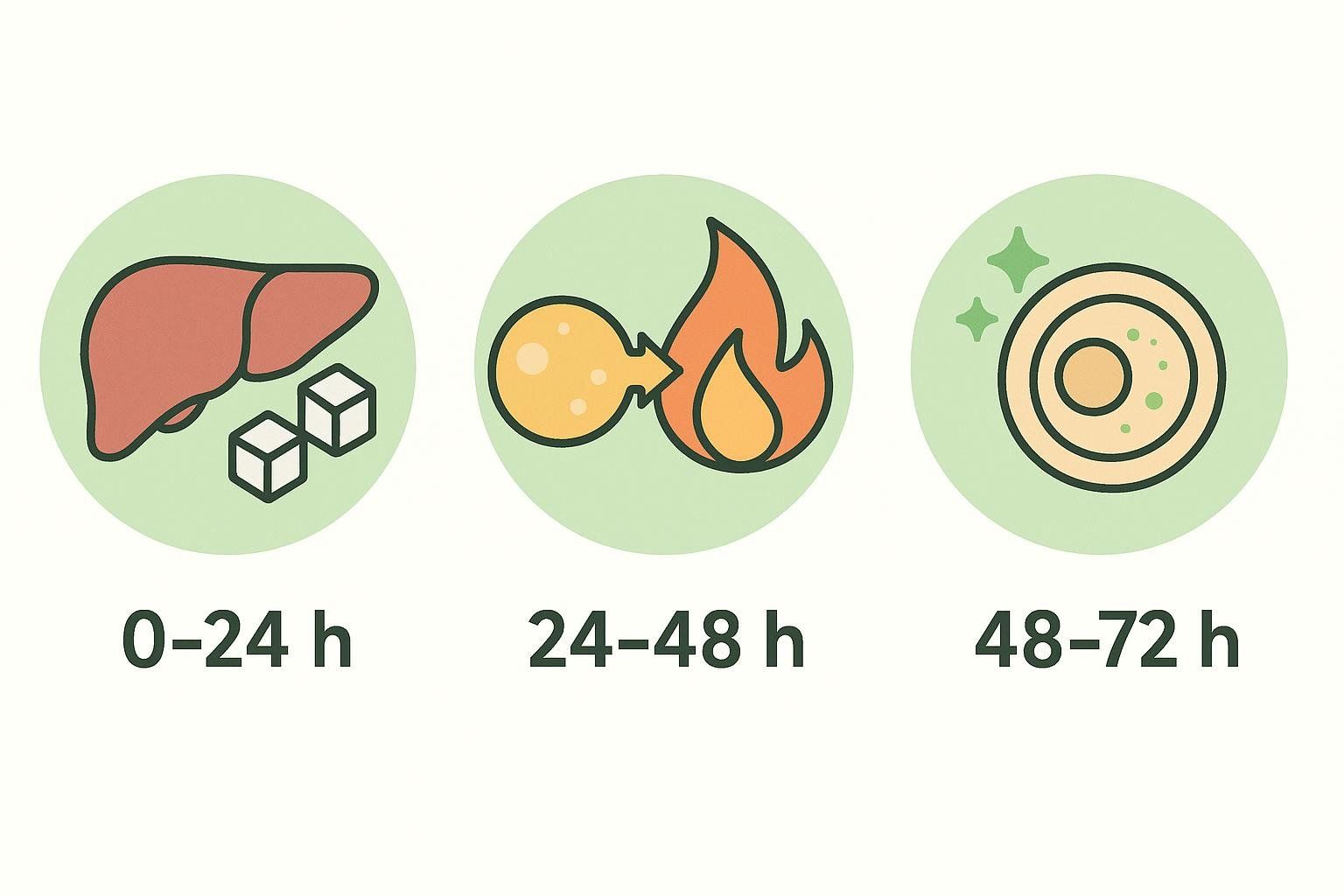
Day 1: Glycogen Depletion and Initial Adaptation
During the first 24 hours, your body primarily burns through stored glycogen (sugar) in your liver and muscles. Research shows that 12 to 24 hours of fasting typically results in a 20% or greater decrease in serum glucose as glycogen stores become depleted, though individual variation is significant based on activity level, body composition, and metabolic health.
What's happening internally:
- Insulin levels drop dramatically
- Growth hormone begins to rise
- Your body starts shifting from glucose to fat for fuel
- Initial water weight loss occurs (typically 1-3 pounds)
- Liver glycogen fuels blood glucose for ~12–18 hours
- Falling insulin prompts kidneys to excrete sodium, leading to rapid water weight drop
Day 2: Ketosis and Fat Oxidation
By hour 24-36, most people enter nutritional ketosis as the liver begins converting stored fat into ketones. Studies show that blood ketone body levels increase within 8 to 12 hours in humans during fasting, providing a steady fuel source for your brain and body.
What's happening internally:
- Ketone levels rise significantly (above 0.5 mmol/L)
- Growth hormone peaks (can increase up to 5-fold)
- Noradrenaline increases, boosting fat oxidation
- The brain starts using ketones, sparing muscle protein
- Fat oxidation accelerates and becomes the primary fuel source
Day 3: Peak Autophagy and Cellular Repair
The third day is when the most profound cellular changes occur. Autophagy—your body's cellular recycling process—reaches peak activity, breaking down damaged proteins and organelles while generating new cellular components.
What's happening internally:
- Maximum autophagy activation
- Continued fat oxidation and ketone production
- Growth hormone can jump five- to ten-fold, helping preserve lean mass
- Potential improvements in insulin sensitivity
- Enhanced cellular stress resistance
- Resting metabolic rate typically remains stable or decreases modestly (≈3–8%)
Recent Research Insights
A comprehensive 2024 study published in Nature Metabolism tracked 12 healthy volunteers through a 7-day water fast, finding that significant health-altering effects appeared after three days. Researchers observed changes in approximately 3,000 proteins, with distinct shifts occurring across all major organs after the 72-hour mark.
Potential Benefits: What Research Shows
1. Enhanced Autophagy and Cellular Renewal

2024 research from Queen Mary University confirmed that autophagy reaches significant levels around day 3 of fasting. This cellular "housekeeping" process helps:
- Clear out damaged mitochondria and proteins
- Reduce inflammatory markers
- Support cellular stress resistance
- Potentially reduce cancer and neurodegenerative disease risk
2. Rapid Fat Loss and Body Composition Changes
Research on extended fasting shows that while longer 5-20 day fasts can produce moderate weight loss of 2-10% of total body weight with fat mass constituting the majority, 3-day fasts have a different weight loss composition:
- Initial weight loss of 4-6% of body weight was observed in 5-day fasts, suggesting proportionally less loss in 3-day fasts
- Water weight and glycogen typically comprise most weight lost in shorter fasts (70-80% of total)
- Actual fat loss may represent only 15-25% of total weight lost (0.5-1.5 lbs for most people)
- Metabolic improvements including enhanced fat oxidation begin during this period
Muscles and liver store ~500 g of glycogen, and each gram binds ~3 g of water. Emptying these stores can flush 2–3 kg (4–7 lbs) of scale weight alone.
3. Improved Metabolic Health
Multiple studies demonstrate that 3-day fasts can:
- Improve blood pressure in some individuals, though fasting studies show variable effects on cardiovascular markers with some people experiencing temporary increases due to acute stress responses
- Improve insulin sensitivity and glucose tolerance
- Lower fasting glucose by 5-10 mg/dL
- Reduce inflammatory markers including C-reactive protein
Research shows that intermittent fasting protocols significantly improved insulin sensitivity and blood glucose control, particularly in individuals with insulin resistance.
4. Cognitive Enhancement and Mental Clarity

Many people report enhanced mental clarity during day 2-3 of fasting. Research on intermittent fasting shows these cognitive benefits likely result from:
- Stable ketone supply to the brain (more efficient than glucose)
- Reduced inflammation affecting neural function
- Increased BDNF (brain-derived neurotrophic factor) supporting neuron health
Will I Lose Muscle in Just Three Days?
Meaningful muscle loss is highly unlikely during a 3-day fast for most healthy individuals. In a week-long water-fast study, only ≈1 lb of the 5 lbs lean-mass reduction was true protein; the rest was water bound to glycogen and other non-muscle tissues.
Shorter 72-hour fasts show even less nitrogen loss. Protein breakdown spikes on day 1, then plummets as ketones rise, limiting true muscle loss to a few ounces over 72 hours. Growth hormone elevation during fasting helps preserve lean mass, often increasing five- to ten-fold by day 3.
Serious Risks and Contraindications
Who Should NEVER Attempt a 3-Day Water Fast
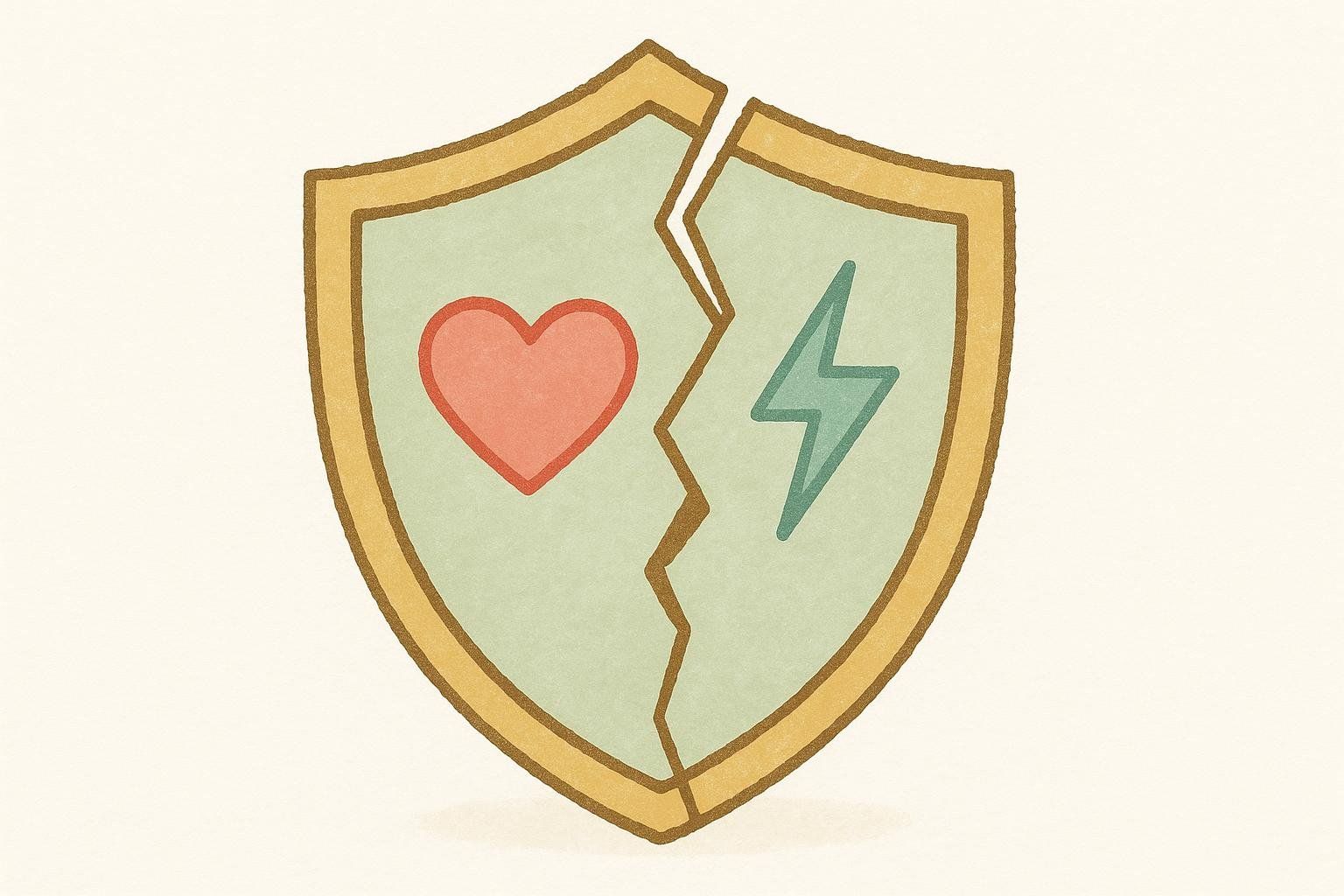
Absolute contraindications include:
- Pregnant or breastfeeding women
- Children and adolescents under 18
- Adults over 65 (without medical supervision)
- History of eating disorders (anorexia, bulimia, binge eating)
- Type 1 diabetes (risk of diabetic ketoacidosis)
- Advanced kidney disease
- Heart conditions including arrhythmias
- Anyone taking prescription medications unless cleared by a doctor
- BMI < 18.5 or recent unintentional weight loss
Dangerous Side Effects and Complications
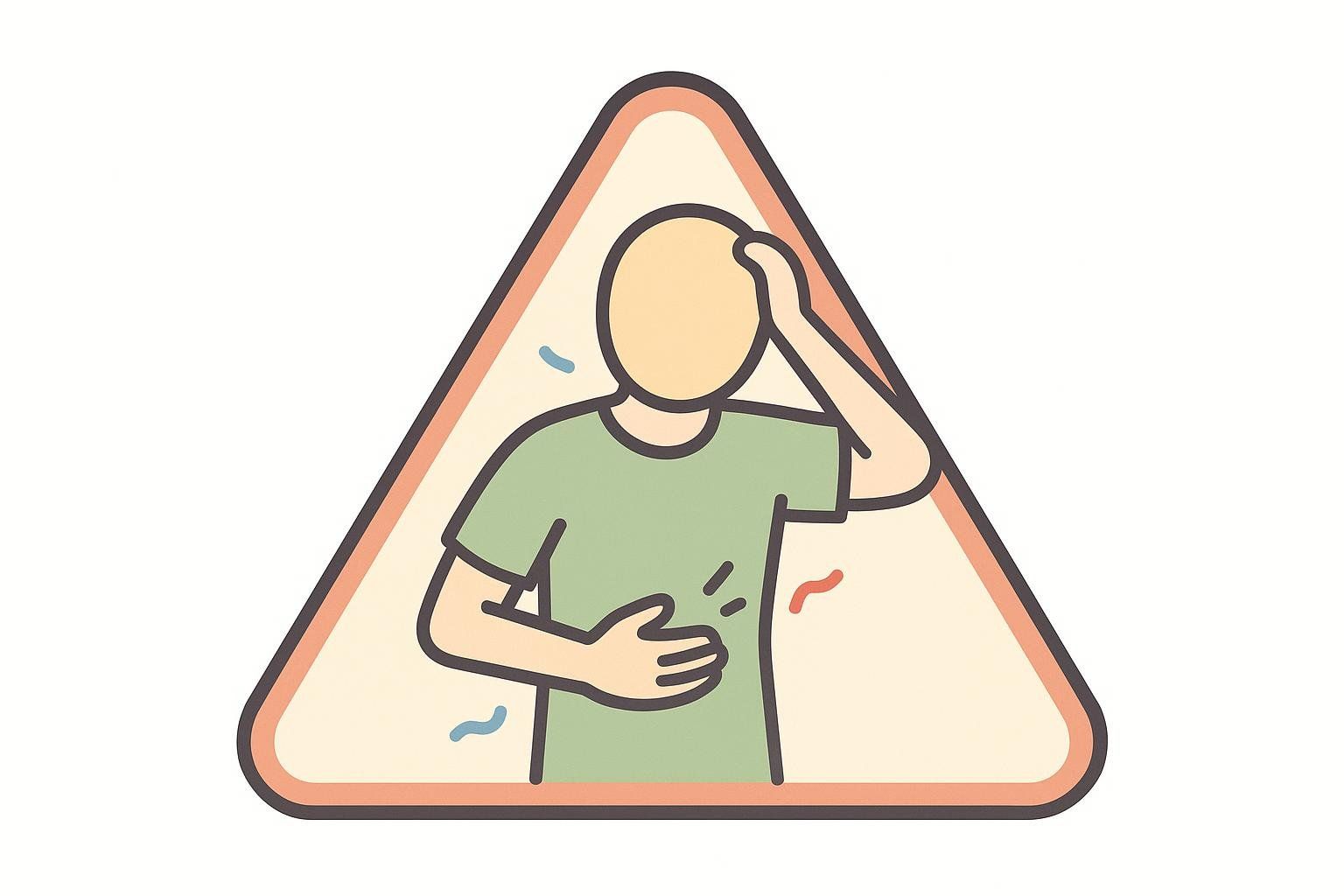
Medical literature identifies several serious risks:
- Can be life-threatening if food is reintroduced improperly
- Causes dangerous electrolyte shifts
- Risk increases with longer fasts
2. Electrolyte Imbalances
- Hyponatremia (low sodium) from excessive water intake
- Potassium and magnesium depletion
- Can cause cardiac arrhythmias and neurological symptoms
3. Dehydration and Orthostatic Hypotension
- Despite water intake, dehydration can occur due to lack of electrolytes from food
- Sudden blood pressure drops when standing (orthostatic hypotension)
- Increased fall and injury risk
4. Metabolic Disruptions
- Extended fasting can elevate cortisol levels as part of the body's stress response
- Increased blood pressure and cholesterol in some individuals as an acute stress response
- Potential muscle protein breakdown
Warning Signs to Stop Immediately
Discontinue the fast and seek medical attention if you experience:
- Severe dizziness or fainting
- Chest pain or irregular heartbeat
- Persistent nausea or vomiting
- Confusion or disorientation
- Severe electrolyte symptoms (muscle cramps, weakness)
Day-by-Day Guide: What to Expect
Day 1: The Hunger Challenge
Physical Experience:
- Strong hunger pangs (typically peak around hour 16-20)
- Mild headaches from glycogen depletion
- Energy fluctuations as blood sugar stabilizes
- Initial water weight loss (1-3 pounds)
Mental Experience:
- Food thoughts dominate
- Slight irritability or mood changes
- Need for strong motivation and distraction
Key Strategies:
- Drink 2-4 liters of water daily, adjusting for personal needs, and avoid excessive intake to prevent hyponatremia
- Light walking helps with hunger and mood
- Avoid food-related media and social situations
- Early bedtime helps manage evening hunger
Day 2: Entering Ketosis
Physical Experience:
- Hunger significantly diminishes (often surprisingly so)
- Ketosis typically begins (can test with ketone strips)
- Sustained energy without food cravings
- Possible "keto breath" (metallic taste)
Mental Experience:
- Mental clarity often improves markedly
- Less food obsession
- Increased focus and concentration
- Sense of accomplishment
Key Strategies:
- Maintain hydration and, if cleared by your healthcare provider, consider adding a small pinch of high-quality salt to some of your water to help manage electrolytes
- Very light exercise only (walking, gentle yoga)
- Journal your experiences for future reference
- Monitor for any concerning symptoms
Day 3: Peak Benefits and Cellular Renewal
Physical Experience:
- Maximum autophagy activation
- Stable energy from ketone production
- Digestive system fully at rest
- Possible improved sleep quality
Mental Experience:
- Peak mental clarity for many people
- Strong sense of self-control and discipline
- Anticipation of breaking the fast
- Spiritual or emotional insights (commonly reported)
Key Strategies:
- Plan your refeeding strategy carefully
- Avoid overconfidence—this is still a medical stress on your body
- Continue monitoring for any adverse symptoms
- Prepare mentally for post-fast eating challenges
Safe Refeeding: The Critical 72 Hours After
Breaking a 3-day fast improperly can be more dangerous than the fast itself. Refeeding syndrome can cause life-threatening electrolyte shifts, particularly in people who are malnourished or have extended their fast beyond 72 hours.
Hour 1-6: Gentle Reintroduction
Follow these steps for safe refeeding after a 72-hour fast:

- Start with bone broth: Consume ½ cup of warm, low-sodium bone broth over 30 minutes
- Wait and observe: Allow 1-2 hours to assess how your body responds
- Introduce soft foods: Add small portions (¼ cup) of easily digestible foods like steamed non-starchy vegetables (such as zucchini), a few berries, or a small piece of avocado
- Continue slowly: Space small meals 2-3 hours apart throughout the day
Foods to avoid during refeeding:
- Large meals or high volumes of food
- High-fat foods (can cause digestive distress)
- Processed or sugary foods
- Excessive fiber or raw vegetables
Day 1-3 Post-Fast: Progressive Refeeding with Specific Targets
Day 1 (First Meal ~300–400 kcal):
- A cup of clear broth for electrolytes
- Two soft-boiled eggs for gentle protein
- Steamed non-starchy veggies for micronutrients
Day 2 (Total intake: ~1,000–1,200 kcal split across two meals):
- Focus foods: lean protein, easily digested carbs (white rice or sweet potato), sautéed or steamed veggies, and fruit
- Skip: alcohol, ultra-rich desserts, and oversized high-fat feasts
Day 3 and beyond:
- Transition toward maintenance calories or a modest deficit
- Aim for 1.2–1.6 g protein per kg body weight
- Reintroduce carbs gradually to avoid sharp glycogen rebound
Research suggests following a Mediterranean-style diet during the refeeding period to optimize the metabolic benefits gained during fasting.
Preparation Protocol: Getting Started
3 Days Before: Dietary Preparation
- Reduce caffeine intake gradually to minimize withdrawal headaches
- Cut back on processed foods and added sugars
- Increase vegetable and nutrient-dense food intake
- Begin drinking more water to prepare for increased intake
1 Day Before: Final Preparation
- Eat a moderate dinner with good protein and healthy fats
- Avoid alcohol completely
- Get adequate sleep (7-9 hours)
- Clear your schedule of stressful events
- Prepare bone broth and refeeding foods
Plan Your Electrolyte Strategy
Electrolyte management is critical for safe extended fasting. Schedule a consultation with your healthcare provider to discuss:
- Appropriate salt intake during the fast
- Whether electrolyte supplementation is recommended for your situation
- Warning signs of electrolyte imbalance to monitor
- Emergency protocols if symptoms develop
Essential Supplies

- High-quality water (filtered if possible)
- Electrolyte supplements, only if recommended by your healthcare provider
- Ketone testing strips (optional but helpful)
- Blood pressure monitor (if you have one)
- Emergency contact information for your healthcare provider
Medical Supervision: When It's Essential
Who Needs Medical Supervision
Healthcare guidance is crucial for:
- Anyone with chronic health conditions
- People over 65 or under 25
- Those taking any medications
- Individuals with BMI under 18.5
- Anyone new to extended fasting
What Medical Supervision Includes
- Pre-fast health evaluation and clearance
- Baseline blood work (glucose, electrolytes, kidney function)
- Daily check-ins during the fast
- Emergency management protocols
- Post-fast health assessment
Some medical professionals offer supervised fasting programs that include continuous monitoring and IV electrolyte support when needed.
Tracking Your Fast: What to Monitor
Daily Measurements
- Weight (expect 1-2 pounds loss per day, mostly water initially)
- Blood pressure (if you have equipment)
- Ketones (optional, using urine strips or blood meter)
- Energy levels (subjective 1-10 scale)
- Symptoms (headache, dizziness, mood changes)
Post-Fast Analysis with DEXA Scanning
Consider a DEXA body composition scan 1-2 weeks after your fast to assess actual body composition changes versus water weight fluctuations. This gold-standard measurement can show whether weight loss came from fat, muscle, or water, providing data-driven proof of your results and motivation for future health decisions.
For accurate before-and-after body composition tracking, schedule DEXA scans to understand exactly where the pounds came from and optimize your approach.
Alternative Approaches: Safer Options for Most People
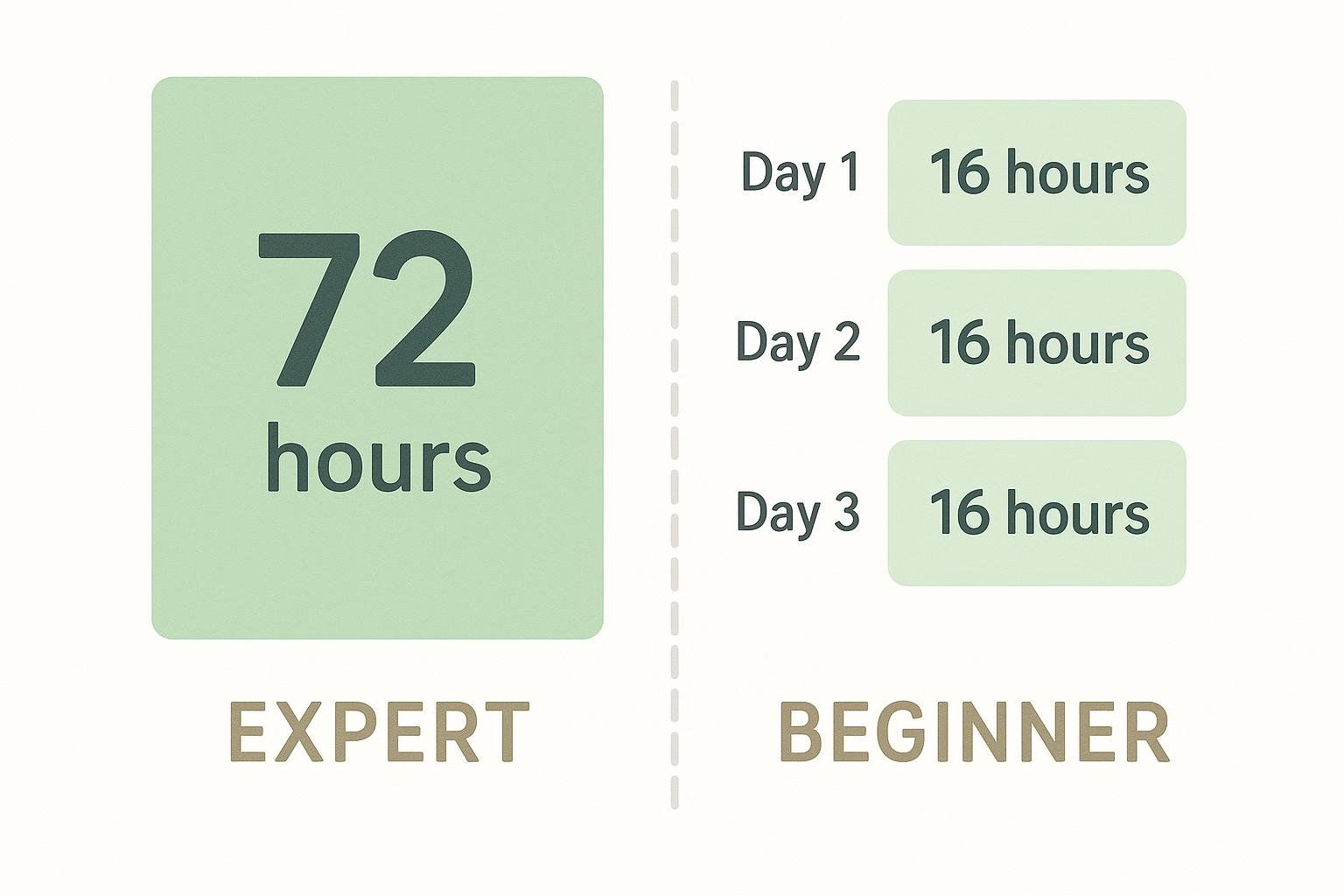
Modified Fasting Approaches
For those interested in many benefits of 3-day fasting without the extreme risks:
- Daily 16-hour fasts with 8-hour eating windows
- Most studied and beginner-friendly approach
- Lower risk while providing significant benefits
- Daily 20-hour fasts with 4-hour eating windows
- Triggers similar autophagy benefits
- Much easier to maintain electrolyte balance
3. 36-Hour Fasts
- Dinner to breakfast (skipping one full day)
- Provides significant metabolic benefits
- Lower risk profile than 72-hour fasts
4. Fasting-Mimicking Diets
- Very low-calorie protocols that simulate fasting
- Include minimal nutrients to reduce risks
- Often done under medical supervision
When 3-Day Fasting Might Be Appropriate
Consider a medically supervised 3-day fast if you meet all of the following criteria:
- You've successfully completed multiple 24-48 hour fasts
- You have specific health goals requiring intensive intervention
- You have access to medical supervision
- You've ruled out all contraindications
- You're prepared for the commitment and potential risks
Even when these conditions are met, shorter fasting protocols or fasting-mimicking diets often provide similar benefits with significantly lower risk profiles.
Frequently Asked Questions
Is a 3-day water fast safe?
A 3-day water fast can be safe for healthy adults without contraindications when done under medical supervision. However, it carries significant risks including electrolyte imbalances, refeeding syndrome, and metabolic disruptions. Most medical professionals recommend shorter fasting periods for the general population.
How much weight will I lose on a 3-day water fast?
Most people lose 2-6 lbs during a 3-day fast, but 70-80% of this is water weight that returns when normal eating resumes. Actual fat loss typically represents only 0.5-1.5 lbs of the total, with the majority being water bound to glycogen stores that depletes during the fast.
How much of the weight comes back after I eat?
Most of the initial water returns once you rehydrate and refill glycogen stores—typically 2–4 lbs within a few days. The fat you lost will stay off as long as your calorie intake remains at or below maintenance.
What can I drink during a water fast?
During a true water fast, only plain water is permitted. Some people add a small amount of high-quality salt for electrolyte balance, but this should be done cautiously. Black coffee, tea, and other zero-calorie beverages technically break a water fast, though some modified protocols allow them.
Will I lose muscle during a 3-day fast?
Meaningful muscle loss is highly unlikely during a 3-day fast for healthy individuals. While the body preferentially uses fat for fuel during a fast, most "lean mass" loss during short fasts comes from water and glycogen depletion, not actual muscle protein breakdown. Growth hormone elevation helps preserve muscle tissue.
Can I exercise during a 3-day water fast?
Strenuous exercise should be avoided during extended fasting due to increased risk of dehydration, electrolyte imbalance, and injury from reduced coordination. Medical guidance suggests light walking or gentle yoga may be acceptable, but listen to your body and stop if you feel dizzy or weak.
How often can I do a 3-day water fast?
There's no established safe frequency for 3-day water fasts. Most research involves single interventions or infrequent repetition. Frequent extended fasting can lead to nutritional deficiencies and metabolic disruptions. If considering repeated fasting, work with a healthcare provider to develop a safe protocol.
Should I take supplements during the fast?
Most supplements break a water fast and should be avoided. The exception is electrolyte replacement under medical guidance if symptoms of depletion occur. Never take fat-soluble vitamins during a fast, as they require food for proper absorption.
What happens if I break the fast early?
Breaking a fast early is not a failure—it's listening to your body. If you experience concerning symptoms or simply can't continue, break the fast safely using the gentle refeeding protocol. Many benefits of fasting occur even with shorter durations.
The Bottom Line: Is a 3-Day Water Fast Right for You?
A 3-day water fast represents an extreme intervention that can trigger profound metabolic changes including enhanced autophagy, rapid initial weight loss (mostly water), and improved insulin sensitivity. However, it also carries significant risks that make it inappropriate for most people without medical supervision.
Realistic expectations are crucial: While you'll likely lose 2-6 lbs on the scale, only 0.5-1.5 lbs typically represents actual fat loss, with the majority being water weight that returns once normal eating resumes.
The decision to attempt a 3-day fast should never be taken lightly. This approach is most appropriate for healthy adults who have extensive fasting experience, access to medical oversight, and specific health goals that require intensive intervention. If you have any medical conditions, take medications, have a history of eating disorders, or are under 18 or over 65, this extreme fasting protocol is not suitable.
For the vast majority of people seeking metabolic benefits, safer alternatives like 16:8 intermittent fasting or 20:4 fasting provide significant advantages with dramatically lower risks. These approaches can trigger many of the same beneficial processes—including autophagy and improved insulin sensitivity—while allowing you to maintain proper nutrition and electrolyte balance.
Remember that the most effective eating pattern is one you can maintain long-term while supporting your overall health and well-being. While a 3-day water fast can provide dramatic short-term results, sustainable lifestyle changes typically produce better long-term outcomes with significantly lower risks.
If you're drawn to extended fasting, start with shorter protocols, work with healthcare professionals, and always prioritize safety over dramatic results. Your health is too valuable to risk with extreme interventions unless absolutely necessary and properly supervised.
